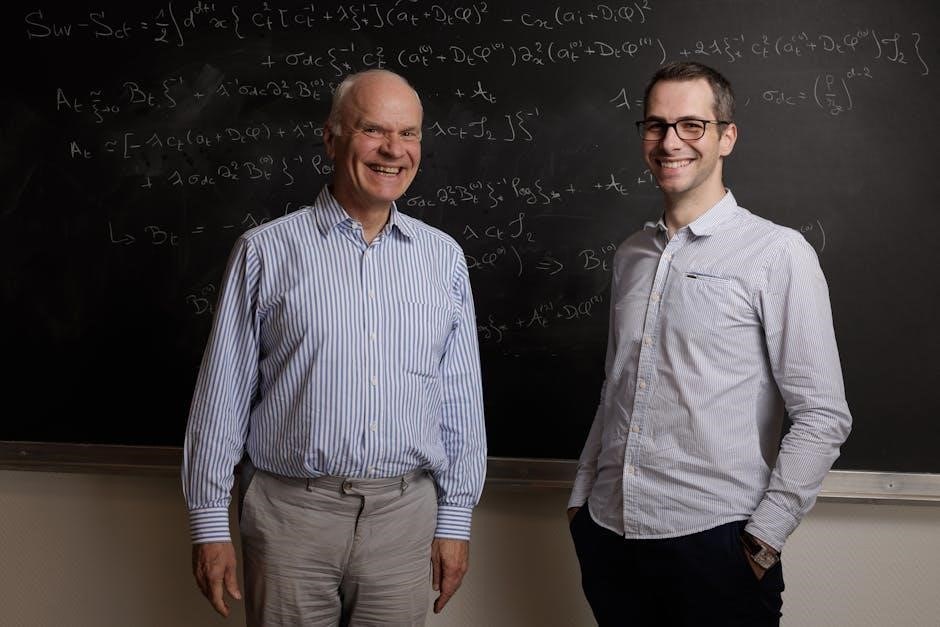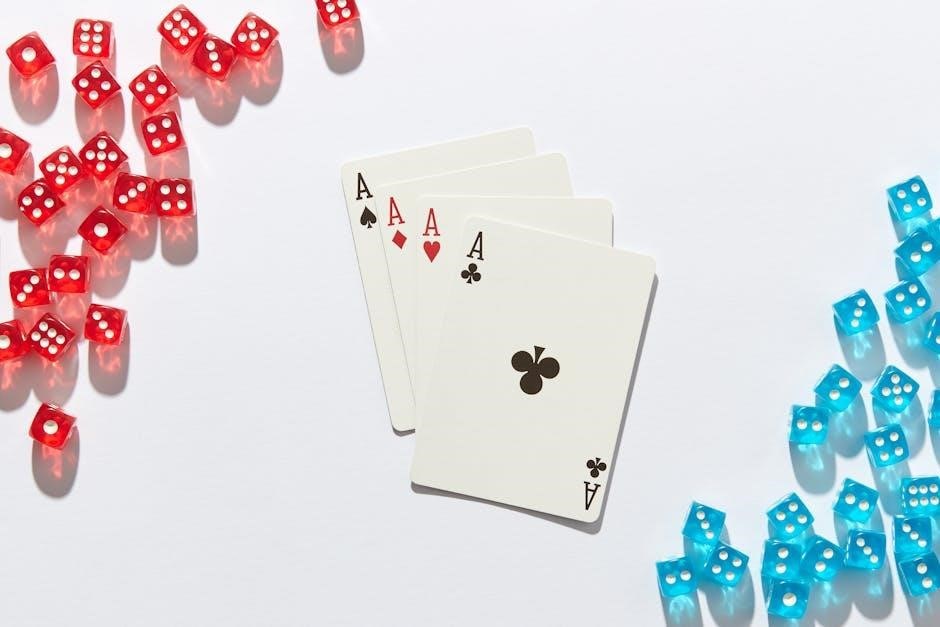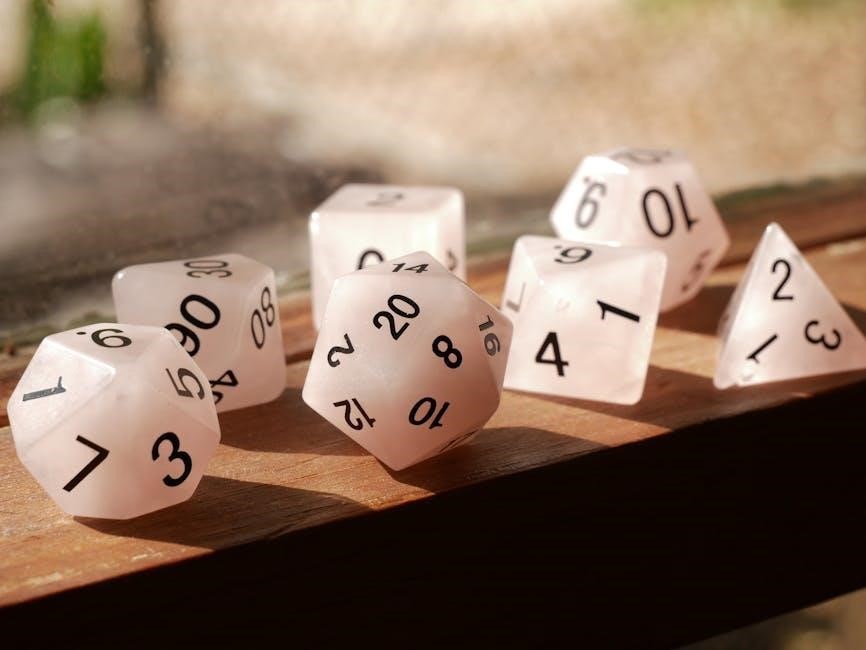theoretical probability pdf
Theoretical probability is a mathematical approach to determine the likelihood of an event, expressed as a number between 0 and 1. It relies on calculations rather than experiments, providing a foundation for predicting outcomes in various fields, including statistics and data analysis.
1.1 Definition of Theoretical Probability
Theoretical probability is the likelihood of an event occurring, calculated using mathematical principles rather than experimental data. It is defined as the ratio of the number of favorable outcomes to the total number of possible outcomes in a given situation. This probability is expressed as a fraction, decimal, or percentage, ranging from 0 (impossible) to 1 (certain). Theoretical probability assumes all outcomes are equally likely and provides a precise measure of event likelihood, forming the foundation of probability theory in mathematics and statistics.
1.2 Importance of Theoretical Probability in Mathematics
Theoretical probability serves as the foundation of probability theory, enabling precise calculations of event likelihoods. It underpins statistical analysis, combinatorics, and stochastic processes. By providing a mathematical framework, it aids in understanding uncertainty and decision-making. Theoretical probability is essential for analyzing sample spaces, identifying outcomes, and calculating probabilities in experiments. Its applications extend to real-world scenarios, such as gambling, lotteries, and risk management. This fundamental concept is vital for advancing mathematical modeling and solving complex problems in various scientific and engineering disciplines.
1.3 Brief Overview of Probability Concepts
Theoretical probability introduces core concepts like sample space, events, and outcomes. The sample space lists all possible results of an experiment, while events are specific outcomes or combinations. Probability measures range from 0 (impossible) to 1 (certain). Key ideas include conditional probability, where one event depends on another, and probability distributions, which describe outcome likelihoods. These concepts form the backbone of probabilistic reasoning, enabling analysis of uncertainty and decision-making in various fields, from statistics to real-world applications like gambling and risk assessment.

Theoretical Probability Formula
Theoretical probability formula calculates the likelihood of an event as the ratio of desired outcomes to total possible outcomes, expressed as P(A) = favorable outcomes / total outcomes, providing a clear method to determine event probabilities.
2.1 Understanding the Formula
Understanding the theoretical probability formula involves recognizing that it quantifies event likelihood by dividing favorable outcomes by total outcomes. For instance, flipping a coin has two possible outcomes, so the probability of getting heads is 1/2. Similarly, rolling a die has six outcomes, making the probability of any specific number 1/6. This straightforward approach allows for precise calculation of probabilities in various scenarios, ensuring clarity and consistency in predicting event outcomes.
2.2 Calculating Theoretical Probability
Calculating theoretical probability involves determining the ratio of favorable outcomes to the total number of possible outcomes in a given scenario. The formula is expressed as P(Event) = Number of desired outcomes / Total number of possible outcomes. For example, when rolling a six-sided die, the probability of landing on 3 is 1/6. Similarly, drawing a specific card from a deck of 52 yields a probability of 1/52. This method ensures precise calculations by focusing on the inherent possibilities of an event, providing a clear and reliable way to predict likelihoods in various situations;
2.3 Reducing Fractions in Probability Calculations
Reducing fractions is essential for simplifying probability calculations. When the numerator and denominator share common factors, dividing both by these factors results in the simplest form. For instance, if an event has 2 favorable outcomes out of 4 possible, the fraction 2/4 reduces to 1/2. This simplification ensures clarity and accuracy in probability expressions. Proper reduction also aids in comparing probabilities and performing further mathematical operations, making it a fundamental step in theoretical probability calculations.
2.4 Experimental vs. Theoretical Probability
Experimental probability is determined through repeated trials, observing the frequency of outcomes. It provides an empirical estimate of likelihood. Theoretical probability, in contrast, is calculated mathematically, based on the number of favorable outcomes divided by total possible outcomes. Both approaches complement each other; experimental results often approximate theoretical probabilities as the number of trials increases. Understanding their differences is crucial for applying probability concepts effectively in real-world scenarios and statistical analysis.

Examples of Theoretical Probability
Theoretical probability is demonstrated through everyday scenarios, such as rolling a die or drawing a card. For instance, the probability of rolling a 3 on a die is 1/6, and drawing the ace of hearts from a deck is 1/52. These examples help students understand probability basics and apply mathematical concepts to real-life situations.
3.1 Probability of Rolling a Specific Number on a Die
Theoretical probability calculates the likelihood of rolling a specific number on a die. A standard die has six faces, numbered 1 through 6, each equally likely. The probability of rolling any specific number is 1/6. This is derived from the formula: desired outcomes divided by total possible outcomes. For example, rolling a 3 has a probability of 1/6. This concept demonstrates the foundational principle of theoretical probability, where outcomes are equally likely and predictable through mathematical calculation. Understanding this basic example helps build intuition for more complex probability problems.
3.2 Probability of Drawing a Specific Card from a Deck

Theoretical probability is applied to determine the chance of drawing a specific card from a standard deck. A deck contains 52 cards, with each card unique. The probability of drawing a specific card, such as the Ace of Spades, is 1/52. This is calculated by dividing the number of desired outcomes (1) by the total number of possible outcomes (52). This example illustrates how theoretical probability provides a clear, mathematical method to assess likelihood in scenarios with defined outcomes, making it a fundamental tool in probability theory and real-world applications like gambling and statistics.
3.3 Probability of Getting a Specific Sum with Two Dice
Theoretical probability helps determine the likelihood of obtaining a specific sum when rolling two dice. Each die has 6 faces, leading to 36 possible outcomes when two dice are rolled. The probability of a specific sum is calculated by dividing the number of favorable outcomes by the total number of possible outcomes (36). For example, the sum of 7 has 6 favorable outcomes, making its probability 6/36, or 1/6. Conversely, sums like 2 or 12 have only 1 favorable outcome each, resulting in a probability of 1/36. This demonstrates how theoretical probability applies to real-world scenarios, providing a mathematical basis for understanding likelihoods in games and statistical analyses.

Sample Space and Outcomes
The sample space is the set of all possible outcomes of an experiment. Each outcome represents a specific result, such as heads or tails in a coin toss.
4.1 Definition of Sample Space
The sample space is the set of all possible outcomes of an experiment. It represents every potential result, ensuring no outcomes are missed. For example, rolling a die has outcomes 1 through 6, and flipping a coin has heads or tails. Each outcome in the sample space is equally likely in theoretical probability, making it a foundational concept in calculating probabilities. Understanding the sample space is crucial for determining the probability of specific events, providing a clear framework for analyzing all possible results and ensuring accurate calculations. This systematic approach is vital in both education and real-world applications, where precise probability assessments are necessary.
4.2 Identifying Possible Outcomes
Identifying possible outcomes is a fundamental step in theoretical probability, involving listing all potential results of an experiment. For example, rolling a die yields outcomes 1–6, while flipping a coin results in heads or tails. Each outcome must be distinct and mutually exclusive. This process ensures clarity and accuracy in calculating probabilities. By systematically identifying outcomes, one avoids missing or double-counting possibilities, which is essential for precise probability assessments. Understanding how to identify outcomes is crucial for applying theoretical probability concepts effectively in various mathematical and real-world scenarios, providing a solid foundation for further analysis and decision-making.
4.3 Types of Sample Spaces (Discrete vs. Continuous)

A sample space can be classified as discrete or continuous. A discrete sample space consists of distinct, countable outcomes, such as flipping a coin (heads/tails) or rolling a die (1–6). Each outcome is separate and finite. In contrast, a continuous sample space involves an infinite number of outcomes within a range, like measuring the time it takes for a bus to arrive (e.g., between 10 and 20 minutes). Understanding these types is crucial in theoretical probability, as they determine the methods used to calculate probabilities and analyze events effectively in various mathematical contexts.

Conditional Probability
Conditional probability measures the likelihood of an event given another event has occurred, crucial in statistics and real-world applications like medical testing and finance.
5.1 Definition of Conditional Probability
Conditional probability is the likelihood of an event occurring given that another event has already happened. It is calculated using the formula:
P(A|B) = P(A and B) / P(B), where P(A|B) is the probability of event A occurring given event B. This concept is crucial in statistics, medicine, and finance, aiding in decision-making under uncertainty. For example, the probability of a patient having a disease given a positive test result, or the probability of rain given cloudy skies, are real-world applications of conditional probability.
5.2 Formula for Conditional Probability
The formula for conditional probability is given by:
P(A|B) = P(A ∩ B) / P(B), where P(A|B) is the probability of event A occurring given that event B has occurred. Here, P(A ∩ B) is the probability of both A and B happening, and P(B) is the probability of event B. This formula is essential for understanding dependent events and is widely used in statistics, finance, and real-world applications like risk assessment and medical diagnosis to make informed decisions under uncertainty.
5.3 Examples of Conditional Probability
A classic example of conditional probability involves drawing cards from a deck; Suppose you draw a card and it is a heart; the probability it is a queen is 1/13. Another example is weather forecasting: if it rains, the probability of a thunderstorm increases. In medical testing, conditional probability helps determine the likelihood of a disease given a positive test result. These examples illustrate how conditional probability aids in understanding dependent events and making informed decisions based on prior occurrences, enhancing predictions in various real-world scenarios.

Probability Distributions
Probability distributions describe the likelihood of different outcomes. Discrete distributions, like dice rolls, involve distinct values. Continuous distributions, like height, involve ranges. They model real-world uncertainty effectively.
6.1 Discrete Probability Distributions
Discrete probability distributions define probabilities for distinct, separate outcomes. Examples include dice rolls or coin flips. Each outcome has a specific probability, and the total probabilities sum to 1. These distributions are fundamental in modeling countable events, such as the number of heads in coin tosses. They are widely used in statistics and machine learning to analyze categorical data and predict discrete outcomes effectively.
6.2 Continuous Probability Distributions
Continuous probability distributions describe outcomes across an infinite range of values, such as time or temperature. They use a probability density function (PDF) to define likelihoods, where the area under the curve represents probability. Unlike discrete distributions, continuous ones assign zero probability to individual points, focusing instead on intervals. Common examples include the Normal (Gaussian) and Uniform distributions. These distributions are essential in modeling real-world phenomena like measurement errors or stock prices, providing a framework for understanding variability and uncertainty in continuous data.
6.3 Real-World Applications of Probability Distributions
Probability distributions are widely applied in real-world scenarios to model uncertainty and make informed decisions. In insurance, they assess risk and calculate premiums. In engineering, they predict system reliability and failure rates. Finance uses them to analyze market trends and portfolio risks. Predictive analytics leverages distributions to forecast outcomes in healthcare, weather, and customer behavior. These applications demonstrate how theoretical probability provides practical tools for understanding and managing variability in complex systems, enabling better decision-making across industries. Their versatility makes them indispensable in modern data-driven environments.

Advanced Concepts in Theoretical Probability
Theoretical probability extends into advanced concepts like the Law of Large Numbers, Bayesian Probability, and Probability Density Functions (PDFs), which deepen the understanding of probabilistic systems and their applications in statistics and data science.
7.1 Law of Large Numbers
The Law of Large Numbers (LLN) states that as the number of trials increases, the experimental probability of an event converges to its theoretical probability. This principle, fundamental in probability theory, ensures that with more trials, results stabilize around the expected value. For example, flipping a fair coin many times will result in approximately 50% heads and 50% tails. The LLN is crucial in statistics and real-world applications like gambling and insurance, where understanding long-term behavior is essential for making reliable predictions and informed decisions.
7.2 Bayesian Probability
Bayesian probability is a statistical approach that updates probabilities based on new data or information. It uses Bayes’ theorem to calculate the likelihood of an event by considering prior knowledge and observed evidence. Unlike classical probability, Bayesian methods allow for subjective probabilities and are widely used in machine learning, predictive analytics, and risk management. This approach is particularly useful in scenarios where data is limited or uncertain, enabling dynamic updating of beliefs as new information becomes available.
7.3 Probability Density Function (PDF)
A Probability Density Function (PDF) describes the likelihood of a continuous random variable taking on a specific value. Unlike discrete distributions, PDFs do not provide exact probabilities but instead indicate the density of probability around a point. The total area under the PDF curve equals 1, ensuring it adheres to the principles of probability. PDFs are essential in theoretical probability for modeling real-world phenomena, such as heights or temperatures, where outcomes are continuous. They are widely applied in engineering, economics, and data analysis to predict and understand variable behaviors.

Practical Applications of Theoretical Probability
Theoretical probability is applied in gambling, insurance, and predictive analytics. It helps assess risks, predict outcomes, and make informed decisions in real-world scenarios.
8.1 Gambling and Lotteries
Theoretical probability plays a crucial role in gambling and lotteries by enabling the calculation of odds and predicting outcomes. In games like roulette or slot machines, it helps determine the likelihood of specific results, allowing players and casinos to assess risks. For lotteries, theoretical probability calculates the chance of winning by dividing the number of favorable outcomes by the total possible combinations. This mathematical approach ensures fair gameplay and informed decision-making. By understanding probability distributions, participants can better strategize, making it a cornerstone of gaming industries worldwide.
8.2 Insurance and Risk Management
Theoretical probability is essential in insurance and risk management for assessing the likelihood of events like accidents or natural disasters. Insurers use probability distributions to calculate premiums, ensuring they balance risk and profitability. By evaluating the probability of claims, companies set fair policy prices. Risk management relies on theoretical probability to identify potential losses and develop strategies to mitigate them. This mathematical approach enables accurate forecasting, helping insurers maintain financial stability while providing reliable coverage to policyholders. It is a cornerstone for actuarial science and underpins the entire insurance industry.
8.3 Predictive Analytics and Machine Learning
Theoretical probability plays a crucial role in predictive analytics and machine learning by providing foundational concepts for understanding patterns and making informed predictions. Probability distributions, such as normal and binomial distributions, are used to model data, enabling algorithms to estimate future outcomes. Machine learning relies on probability theory to assess the likelihood of different outcomes, enhancing decision-making processes. Bayesian networks, a key tool in machine learning, heavily depend on conditional probability to update predictions based on new data. This integration of theoretical probability into advanced analytics drives innovation in fields like finance, healthcare, and marketing.
Theoretical probability provides a mathematical framework for understanding randomness, offering precise tools to predict and analyze events, making it indispensable in both academic and real-world applications;
9.1 Summary of Key Concepts
Theoretical probability is a mathematical framework for predicting event likelihoods, calculated as desired outcomes over total possible outcomes. Key concepts include sample space, conditional probability, and probability distributions. It applies to discrete and continuous variables, with real-world uses in gambling, insurance, and machine learning. Theoretical probability differs from experimental probability, which relies on repeated trials. Understanding theoretical probability involves grasping concepts like conditional probability, probability density functions, and the law of large numbers. These principles form the foundation for analyzing randomness and uncertainty in various scientific and practical contexts, providing precise tools for decision-making and prediction.
9.2 Importance of Theoretical Probability in Real Life
Theoretical probability plays a crucial role in real-life applications, enabling informed decision-making under uncertainty. It is essential in gambling and lotteries, where understanding odds is vital for strategic choices. In insurance, probability helps assess risks and set premiums accurately. Additionally, it is fundamental to predictive analytics and machine learning, where models rely on probabilistic outcomes to forecast future events. Theoretical probability also aids in quality control and financial investments, providing a mathematical basis for evaluating risks and opportunities. Its applications span various industries, making it a cornerstone of modern data-driven decision-making processes and problem-solving strategies.
